|
TennisOne Lessons The Compact Stroke Doug King In an earlier article I wrote about how I felt the game of tennis is getting faster, more aggressive, and “smaller,” and that tennis was beginning to look more and more like table tennis. My belief is that the techniques of grip, footwork, swing paths, weight shift, and spin are essentially speeding up the game and making the racquet feel more like a ping pong paddle in the hand. The premise is that the more that you can get the racquet to move in the same timing and the same feel as the hand, the more speed and control you gain.
The reason the game of golf is so challenging is because the club head is so far away from the hands and the hands are so far away from the body. This makes it very difficult to control contact, even though the ball is not moving. Basically, the longer the club and the longer the swing arc, the more difficult the swing is to time and control. Table tennis, by comparison, is much more “natural” or instinctive because the paddle is essentially part of the hand. By keeping the swings more compact we gain better control of the racquet and get more of a feel for playing the game with the hand. This notion of making the strokes more compact is at the heart of the "modern game." When I published this piece a colleague of mine, Jeff Counts founder of Hi-TechTennis.com, sent me a video which corroborated some of my thoughts, reiterated some of the teaching techniques that I have found useful, and also introduced me to some new ideas. The video showed a world renowned table tennis player and instructor demonstrating a technique for learning fundamental topspin in the table tennis forehand. In it he used a ramp as part of an exercise to get the feeling of the hand lifting and rolling a large ball forward. What I have done is build a very similar training aid and added a tennis racquet into the process (see video 2). The use of this training aid highlights some important aspects of stroking mechanics that I would like to address in this article. One is creating a linear arm thrust/lift through contact; two is proper grip; three is wrist/forearm roll, and four is trunk/shoulder rotation. Notice that some of these forces are linear (the arm thrust) and some are rotational (trunk/shoulder and wrist/forearm). But before we get to these points I would first like to discuss the notion of a “compact” stroke. The Modern Compact Stroke Acceleration In my opening statement I suggested that today’s strokes are more compact than those of many years ago. I understand that some would counter that assertion noting that today’s strokes are much more loopy and whippy and in general, bigger - and I wouldn’t disagree. However my definition of a compact stroke is not based solely on the size of the stroke. More important is how energy is released in the stroke. If the essential transfer of power from racquet to ball can be triggered quickly and in a short space, that is, if the stroke can create good acceleration through contact, then it has one important characteristic of a compact stroke.
Take a look at some of the best strokes in the game (Nadal’s forehand or Henin’s backhand) you may see both as having a generous backswing and a generous follow-through, but you will also see that they trigger the release of energy at contact with great acceleration in a very consistent, stable way. You may have a short stoke but if you cannot create what I call, “Critical Acceleration,” with that stroke then you will be late with the stroke and the ball will constantly be playing you. You will be dragging or casting the racquet through contact and this will cause late hitting no matter what size of swing you use. In fact, a certain length of backswing may be necessary in order to build up sufficient momentum in order to coil sufficiently to make the release of energy quickly enough to achieve the critical acceleration necessary to qualify as a "compact" stroke. Let's compare a few different stroking styles to illustrate these points. John McEnroe’s style of play was generally considered to be quite “compact.” His groundstrokes were typified by relatively straight back, minimal backswings with little grip change or wrist action. Conceivably this would be what most people would equate with a compact swing. However this type of action is lacking some critical stroking elements that result in a quick acceleration of the stroke through contact. Without the more “modern” grips he lacked a buildup of tension in his forearm to produce significant acceleration; thus his grip caused him to produce a rolling action of the racquet face over the ball to achieve topspin rather than to drive more aggressively through it with a more stable wrist and forearm position (see Dave Smith’s article about “keeping the plane the same”). This ability to maintain wrist and racquet stability through the contact zone is another defining characteristic of a compact stroke. Hence his style of play falls outside of what we see in the higher speed game of today.
This is not to minimize McEnroe's skill or effectiveness but his game was based more upon using his opponent’s power by taking the ball early and advancing to the net for deft volley finishes. His baseline game was most effective when he utilized this strategy rather than trying to out-hit an opponent from the baseline. Thus one could say that a shorter stroke with less grip change, less flex, and less coil tends to lack critical acceleration resulting in slower swing speed and a tendency to be late when adding power and spin to a stroke; often what we call “getting through the ball.” Compare this to Nadal (above) or other modern day players. First we see that there is a different grip – either a full eastern or a semi-western (the most popular). This grip allows the racquet more to approximate a ninety degree angle to the forearm at contact. This grip also forces the arm to twist and coil in order to bring the racquet face into proper hitting position for contact. This twisting of the arm brings the elbow and forearm into a tighter position to the body through contact. (Think of doing a push up with your elbows in tight to the body versus further out from the body and you get an idea of the different degrees of strength and support). The Linear Arm Thrust/Lift and the Pool Cue Stroke Model Secondly we see much more lifting and dropping of the arm and more bending and straightening of the legs and back. This allows the arm to build up more momentum and speed through the use of gravity at the critical moment of contact, i.e. acceleration into and through contact and to produce the next element of a proper compact topspin stroke which is a stabilized lifting/thrusting action. In addition to critical acceleration, another element of an effective compact stroke is what I call the linear arm thrust/lift through contact. Linear movement, as the term implies, refers to movement in a straight line. The advantage of keeping things in a straight line is that we gain precision of alignment and therefore accuracy. We keep things “lined up.” The problem with linear movement is twofold; first, it is very difficult to create proper acceleration with linear movement and second, the human body is not particularly designed to produce linear movement. Most of the body parts are designed to move in arcs. The limbs are segments that swing in arcs. The shoulders move back and forth around the spine in rotational movements. So in reality, the body tends to move in rotational actions not in straight lines. Ergonomically the body moves more efficiently in rotational motion. Another consideration is that in topspin strokes we are not striving for a perfectly straight swing path; that is a straight path through the ball and out to the target. A straight arm swing is too long and slow and will not produce any spin. Remember that spin is critical to controlling trajectory and power. Therefore, we also combine lift with the thrust (acceleration), which is still a linear movement but the “lift” denotes that there is not a perfectly straight line through the ball and to the target point, but instead, a lifting from below to above that line: an accelerated lift that rolls the ball forward on that line just like the pool cue action shown in the video (2). This is one of the most critical aspects of power tennis and that is the tennis stroke is a lifting action rather than a straight forward swinging action. Vic Braden says that the single most common error made by club players is that they do not get under the ball and “lift” the ball, and that tennis is a “lifting” motion. I completely agree but would suggest that there are many technical aspects that result in a proper compact lifting action, more than simply getting your racquet below the height of the eventual contact point.
Even though we never strive for nor achieve perfectly straight movements, the concept of a more linear stroke is still something that should be considered and applied in our stroke mechanics. Lines create axis and channels that the movements revolve around. They, in a sense, hold things together. Let me explain; imagine your body and how you hold balance by trying to keep a relatively straight line through the spine. Of course when we move in tennis we never try to stay perfectly straight. To do so would be restrictive and result in poor movement. But we still maintain an awareness of that axis that helps us to have reference and keep things under control. In the same way we build our stroke around a linear path from behind and through the ball and out to the target. How much we stay on that line depends upon a number of factors (our physicality, our anatomy, our grips, the specific conditions of each shot that arises, what kind of a shot we are attempting, and so on) but we never lose awareness of that line. Keeping a “linear awareness” to the stroke is a critical issue to producing proper alignment and maintaining accuracy. In a sense, linear axis and rotational motion act in complimentary ways to create dynamic, continuous, and controlled movement. Many people make the mistake of confusing a more linear stroke with a straighter arm. Actually this is far from the truth. In fact the body must move in bends and twists in order to produce more linear action through contact. We are not trying to get the arm to stay straight or feel straight in a more linear swing but instead we are trying to get the hand (or racquet) to travel in a straighter line. There is a huge difference. Let me give you a very simple illustration of this point. A pool cue stroke would represent a very “linear” stroking motion. The pool cue is a straight stick and it is moved back and forth in a straight line motion. One hand steadies the tip of the cue while the other hand pulls back and pushes forward on the other end to produce a straight line action. The pulling and pushing arm, however, must perform a series of bends and flexes in order to produce this straight line action. The shoulder contracts and then the elbow bends and then it pushes back forward to straighten out again. Even the body will rotate slightly in order to allow the shoulder to move back and forth in the motion. This bending and straightening (pulling and pushing) action is what allows the hand to move in a relatively straight line. The arm, the hand, and the sweet spot of the cue (the tip of the pool cue) have very solid alignment providing maximum control. The critical thing to realize is that when we talk about keeping the stroke linear what we are referring to is being able to move the hand in a relatively straight path through the contact zone - it does not mean keeping the arm straight.
If we use the pool cue stroke as a model of linear stroking we can get an understanding of the basic arm and body action through contact. As we practice our tennis stroke using the pulling back and pushing out action of the arm similar to the pool cue stroke, the arm will automatically lift up to produce a natural topspin action. This is because as the hand is pushed forward it will naturally rise to the height of the shoulder (where the arm is attached). Anytime the elbow is pushed away from the body it will automatically lift. So even in a linear thrust we will invariably get some deviation from a straight line. If we push the elbow out from the body we will produce a natural lifting (topspin) action. This linear thrust is also critical in keeping the stroke more compact or condensed. This straight line back and forth action reduces the size of the stroke since a straight line is the shortest path between two points. You can imagine the difficulties of trying to accurately get a pool cue to strike a ball if you swung the pool cue around the body in a wide arcing pendulum motion. Not only would you lose accuracy but you would also require much more time to produce the movement. . In fact just the term “swing” implies a motion that is contrary to a compact action. You could say that building a compact stroke is akin to eliminating any swinging action through contact. The compact action instead, is a lifting accelerated thrust that is supported and driven by the body. Any feeling of “swinging” the racquet necessarily constitutes a non-compact motion. Getting the Body into the Shot This concept leads me onto a slight tangent and that is the notion of “getting the body into the shot.” As I stated above the feeling of driving through the ball is not as much a racquet swinging feeling as much as it is a body lift and thrust. It should feel as though the energey and support are coming out of the “guts” or core of the body. This is not to say that the hand is stiff. If anything, I would say that the racquet almost “settles into the hand through contact and the racquet is barely even felt on a properly struck ball. The question then arises as to exactly how does the body add power to the shot since it is not the body that actually hits the ball. Most people argue that “getting the body into the shot” is a critical means of producing power. Others argue that getting the body into the shot is irrelevant to power and that racquet speed is the only thing that is significant to creating power, since it is the racquet that is the only thing that hits the ball. But I would suggest that we asking the wrong question. I would suggest that “getting the body into the shot” in the prescribed method that we are all familiar with is significant not in how it produces speed but in how it produces control. Using the body properly allows us to produce force with the proper components of rotational and linear motion that result in proper alignment, acceleration, stability, and spin through contact. I could easily whip the pool cue around and create speed but that would not in any way relate to producing a stroke that has the proper effect on the ball. To achieve proper accuracy, timing, spin, and speed I must use a series of flexes, rotations, and pulling and pushing actions. In other words I must activate a full engagement of the legs, hips, core, shoulde, and arms. Does this create more speed in the racquet? Not necessarily. It is, however, the best way to produce speed and maintain a stroking action that produces the desired result on the ball. Thus we should never restrict the concept of “getting the body into the shot” to simply a matter of producing speed or power – it is much more. Although this linear thrust/lift establishes a strong foundation for proper stroking, it is insufficient to produce the critical speed necessary to result in effective spin and the acceleration necessary to cope with the demands of a high speed game. This is where we introduce rotational movement (also referred to as angular motion). The Wrist Action: The “Fold And Roll” and the Rubber Band Plane Model The first rotational motion we will look at is in the wrist and forearm. There is always a great deal of debate as to the use and role of the wrist in the modern topspin stroke. Certainly when we look at top players we see a significant amount of wrist flexion and rotation. The truth is that a significant amount of the racquet speed is produced by the wrist/forearm flex and roll. This is because this is the smallest radius of the body segments that are involved in the stroke and therefore it can produce the most speed in the shortest period of time of any of the body parts. This does not mean that excessive wrist action is not a ver y common problem, however improper wrist action is easily misunderstood and diagnosed. In fact the wrist will almost naturally stabilize during contact and much of the wrist action we see is the result of the arm structure breaking down due to poor mechanics or timing. The critical aspect of the wrist action is that it should never be so extreme or powerful that it causes the path of the hand to pull off line. This overuse of the wrist actually happens not through the contact but more in the backswing or the forward part of the swing prior to contact. The wrist must be very pliable and be able to fold so that the racquet can form as close to a ninety degree angle to the wrist as possible at contact. This 90 degree angle between the racquet and the forearm provides maximum support of the wrist/hand at contact and it also is important in allowing the arm to execute an accelerated linear thrust to the target through contact. Through the pulling and pushing action of the hand in the stroke the wrist will also execute a controlled flex and winding and unwinding around the forearm. This wrist rotation provides an additional build up and release of force (spring action) that not only provides more speed to the racquet by utilizing the smaller swing radius of the wrist but it also provides a counter movement that creates a resistance to the linear thrust, thus adding more acceleration to the thrust action when that resistance is released. Therefore, when the wrist is used properly it creates speed in two ways, one by making the swing smaller and quicker and two by adding more spring to the arm action.
Through the contact zone this wrist/forearm roll is often referred to as a “windshield wiper action“ as the racquet rotates more on a plane that is near parallel to the net rather than the tip of the racquet snapping straight out towards the net. This takes practice to develop the control, feel, and timing of this forearm/wrist roll but it is the basis for developing “Critical Acceleration” mentioned earlier. Another image that I like to think of is a rubber band model airplane. Think of how the propellers on these models are wound up and then unwound. This is somewhat similar to the winding and unwinding of the racquet in the modern topspin stroke. Using the plane/propeller analogy there is linear action of the plane as it flies in a basically forward direction while the propeller rotates around the nose of the plane. In reality there is a usually some forward release of the wrist and racquet towards the net as the wrist roll is executed. The tendons in the forearm stretch and wind much like how the rubber band winds in the model airplane. If we think of the model airplane analogy, you can imagine that the racquet/propeller winds up on the takeback and then when the airplane starts forward it begins to liftoff so that there is “lift“ to the stroke and then the unwinding occurs just as you go into contact with the unwinding of the racquet/propeller. At the same time, even though the arm is extending in a relatively straight line out towards the target, the release of the racquet will pull along the hand and then the arm, causing them to follow the racquet in a wrapping action around the opposite side of the body. All of this folding and rolling of the wrist and forearm should be performed in a fluid rhythmic manner. I prefer the action we see from players like Agassi, Federer, Nadal and most of the men players on the pro tour where the wrist is set in a rather neutral position at the top of the backswing and then allowed to flex at the bottom of the drop in the backswing (compared to how some of the female pros tend to lock the wrist early in the stroke). The reason I prefer this is because this more neutral position keeps the arm more relaxed at the top of the backswing. This allows the arm to drop in a more fluid way, almost like a “dead weight drop” which will help the arm fall into the slot more effectively. Also, this later wrist flexion that occurs in the very last moments prior to contact creates a more dynamic action that allows the wrist more flexibility in creating nuanced adjustments through contact.
Typically in today’s classic topspin forehand we will see the palm of the hand and the racquet face towards the ground at the start of the takeback (wrist relatively neutral). At the bottom of the loop in the backswing the hand has rotated so that the knuckles are facing to the ground and the palm is facing straight to the sky. Also notice how the butt of the racquet comes at the ball; often time flexing into this position very close to contact. This is another fundamental aspect to creating critical acceleration. This last moment flexing of the wrist and racquet away from the ball is the means by which we create the forearm/wrist roll that will produce speed. The problem many people have is that they are insecure in letting the racquet flex “out of position” to the ball and they get the racquet “too” lined up.” This will cause a “dragging” or pushing of the racquet through contact and undermine critical acceleration. At the end of the roll the knuckles will be on top (on the FH) and the roll will tend too pull the hand back and to the left so that the butt of the racquet is now facing out towards the target and the forearm is drawn across the body to form a ninety degree angle with the upper arm. The upper arm usually holds the line towards the target as the elbow will end up pointing out to the target with the shoulder against the side of the face on the finish. Players will typically “sight” down this line, watching the ball advance to the target, much like a marksman will sight through a scope on a rifle. Of course the ability to execute the rolling action described above and achieve critical acceleration without turning the stroke into a whippy mess requires a great deal of practice and involves numerous considerations not covered here. One of these considerations is the “linear aspect” of the stroke that provides reference and control. Body Rotation: The Shoulder Turn Another critical rotational movement is the trunk of the body. The body rotates around the spine in order to draw the shoulder back and forth. Although we usually see and feel this motion as a “rotation,” it can still have a linear orientation to it. If we look back at the pool cue stroke, we can see the shoulder action as either a rotational movement or a linear movement. As more power is involved in the thrust it starts to add more elements of shoulder rotation but through the contact it can be driven in a more linear thrust. Thus we can vary the intensity of the rotational action depending upon the circumstances. By in large, people underestimate the significance of the contribution that the shoulder rotation or thrust provides to the forward aspect of the stroke. If you look at the actual contact of most strokes, what you will see is that the arm is basically lifting and the shoulders are driving forward. The trunk of the body provides an incredibly stable and powerful platform that both supports and propels the arm through contact. The forearm rotation adds significant speed (as mentioned in the above section) but the body provides the stability and the “launching platform” for the arm. And because the hips are rotating in a narrower circle around the axis of the spine, they also rotate more quickly than the racquet actually “swings” around the spine. Therefore, the hips and ribcage rotate much faster than we realize. If we get the arm to fall in passively to the rotation of the trunk of the body, the arm and hand can move surprisingly fast, provided we have the leg and core strength and coordination necessary to move these parts (hips and shoulders) with speed and control. This is why we see the butt of the racquet pointing at the ball as the racquet is coming into contact; it is, to quite an extent, the rotation of the hips and shoulders that actually bring the racquet face square to the ball. On the forward phase of the stroke the arm rotates and slides into the slot where the elbow tucks in to the front of the hip and the butt of the racquet is pointing at the oncoming ball, then, at the last moment the hips and shoulders rotate to quickly bring the racquet face square to the contact point. Right at the contact the shoulder drives out to the target. Analysis of the Modern Compact Stroke To properly execute the wrist/forearm roll the first thing is to get the correct grip. The optimum grip is a Semi-Western. The grip is so important to affecting the build up of tension in the arm and also the positioning of not only the racquet in the hand but the arm to the body. It really sets in motion a full series of movements and positions that form an entire system of energy transfer.
Just as an Eastern Forehand grip would promote a flat slapping contact on the serve and a Continental would promote a proper wrist snap and rotation, so too do grips define the other strokes. The series of still pictures of Serena Williams show the critical positions of the forehand topspin drive. First the grip (figure 1) should be oriented as soon as possible during a stroke. On the take back the racquet head is held above the wrist. This is accompanied with a shoulder rotation to put the body in an approximate 45 degree angle to the net. Second we see the retraction of the elbow (figure 2) just like in the pool cue stroke. The important thing is to not swing the hand or the racquet back at this point which is a common mistake among recreational players. This will cause a loss of balance and will undermine any chances of producing a compact stroke.
During this phase of the stroke we can see the wrist gradually increasing the degree of flexion. The exact elbow position may vary from player to player (Agassi for example was much further out to the side of the body than what we see from serena) but the important thing is that the elbow is being drawn back rather than the racquet being swung back. We also see that the shoulders continue to wind beyond the 45 degree angle. Next is the drop of the elbow in the back stroke (figure 3). This is where gravity is used to help increase momentum and from this point the stroke must stay continuous until completion. The arm is allowed to fall and in doing so it will automatically come forward. At the bottom of the down stroke the wrist will be relatively neutral as there is a general relaxing at this point. During this phase the racquet is allowed to "flow" back in the hand and in some cases we will notice a re-gripping occurring (relaxing of the grip). This may be a good technique for players who tend to grip too tightly, causing the arm to become too extended and the stroke to decelerate. At this time the shoulders begin to rotate forwards towards the net, slightly ahead of the arm.
Just as the hand begins to reach the lowest point in the drop (figure 4) the wrist will increase flexion and the knuckles will rotate underneath so that the palm of the hand rotates up towards the sky. At full wrist flexion the knuckles are making a fist towards the side fence. This rotation of the racquet back will naturally push the elbow forward and it is critical not only to the aligning of the racquet face into the 90% angle to the forearm but also in adding force to the elbow driving into the “slot” (the area just in front of the ribs). This requires a good deal of flexibility and strength and it also requires a good deal of confidence as the player is essentially rotating the racquet out of alignment to the oncoming ball at a time when contact is fast approaching. This, however, is the secret to producing the real essence of the compact stroke which is that final release of energy and critical acceleration. As the hand approaches contact with the ball (figure 5) the racquet head is restrained back until the last possible moment and then just at the right moment the forearm and wrist are released into a controlled, fluid rolling action as the knuckles rotate over and at the same time drive out towards the target.
This is much like how a boxer or a karate master executes a punch - a linear thrust with forearm rotation. We can see that the racquet head rotates from a position below the wrist to above the wrist through contact indicating a release of energy, resulting in acceleration and spin. There will also be a natural acceleration of the racquet head from slightly behind the hand to slightly in front of the hand with this controlled wrist/forearm roll. At this point the shoulder rotation is halted to allow the arm to make a precise extension to the target (linear thrust). The head is held in position to act as a break against the shoulder, stopping it’s forward progress at this critical moment. The wrist and forearm will continue this relaxed, fluid roll (figure 6) which will eventually pull the hand away from the target. Notice that as the hand is pulled away, the shoulder still holds position, keeping the upper arm and elbow remaining pointing out to the target. Eventually even the upper arm is relaxed and the body is allowed to continue to rotate as energy is returned back to the body in recovery mode. Summation As we study the various stages and positions of the stroke as detailed in the above still pictures, it is important to remember that key to keeping the stroke compact is keeping it fluid and keeping all of the parts working in rhythm with each other. It is based upon timing and feel as well as grips and positions. Remember that creating a compact stroke is not just about the overall size of the stroke. It is about your ability to create critical acceleration through the contact so that you are not dragging, muscling, and breaking down through contact. In fact in some cases a larger stroke may be called for in order to create adequate momentum to achieve acceleration. But whatever the size of your stroke it is important that it is built upon a proper structure that includes elements of a linear thrust/lift combined with rotational force. Like everything else it is a matter of blending complimentary elements – you could say it is what we always strive for in “striking a balance.” In the next article we will continue looking at the critical elements of the compact stroke focusing on the timing of the compact stroke and borrowing from techniques in martial arts and boxing to help build an effective model. Your comments are welcome. Let us know what you think about Doug King's article by emailing us here at TennisOne.
Doug is one of the country's foremost tennis teaching innovators. Founder of Acceleration Tennis, a revolutionary teaching system, King is leading the way in reinterpreting the traditional tennis model. Doug King is currently Director of Tennis at Meadowood Napa Valley ( www.meadowood.com ), a Relaix Chateau Resort in St. Helena , CA . For more information on Acceleration Tennis please email Doug King at dking@meadowood.com. |
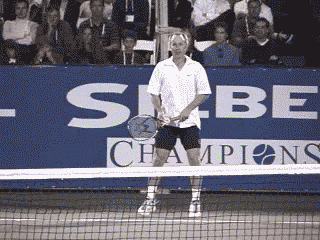
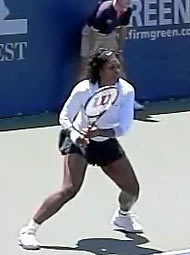
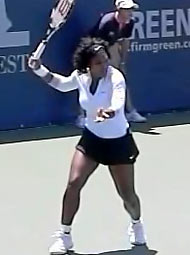
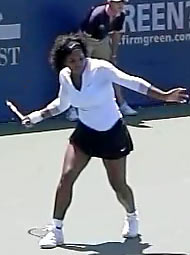

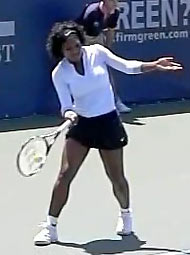
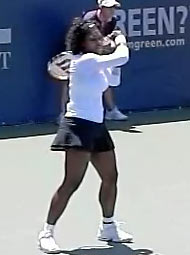
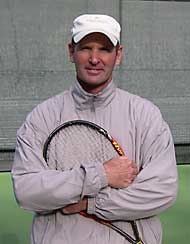
 Doug King studied with legendary tennis coach Tom Stow and was a
former California State Men's Singles Champion
and the former number one men's player of Northern California.
Doug King studied with legendary tennis coach Tom Stow and was a
former California State Men's Singles Champion
and the former number one men's player of Northern California.